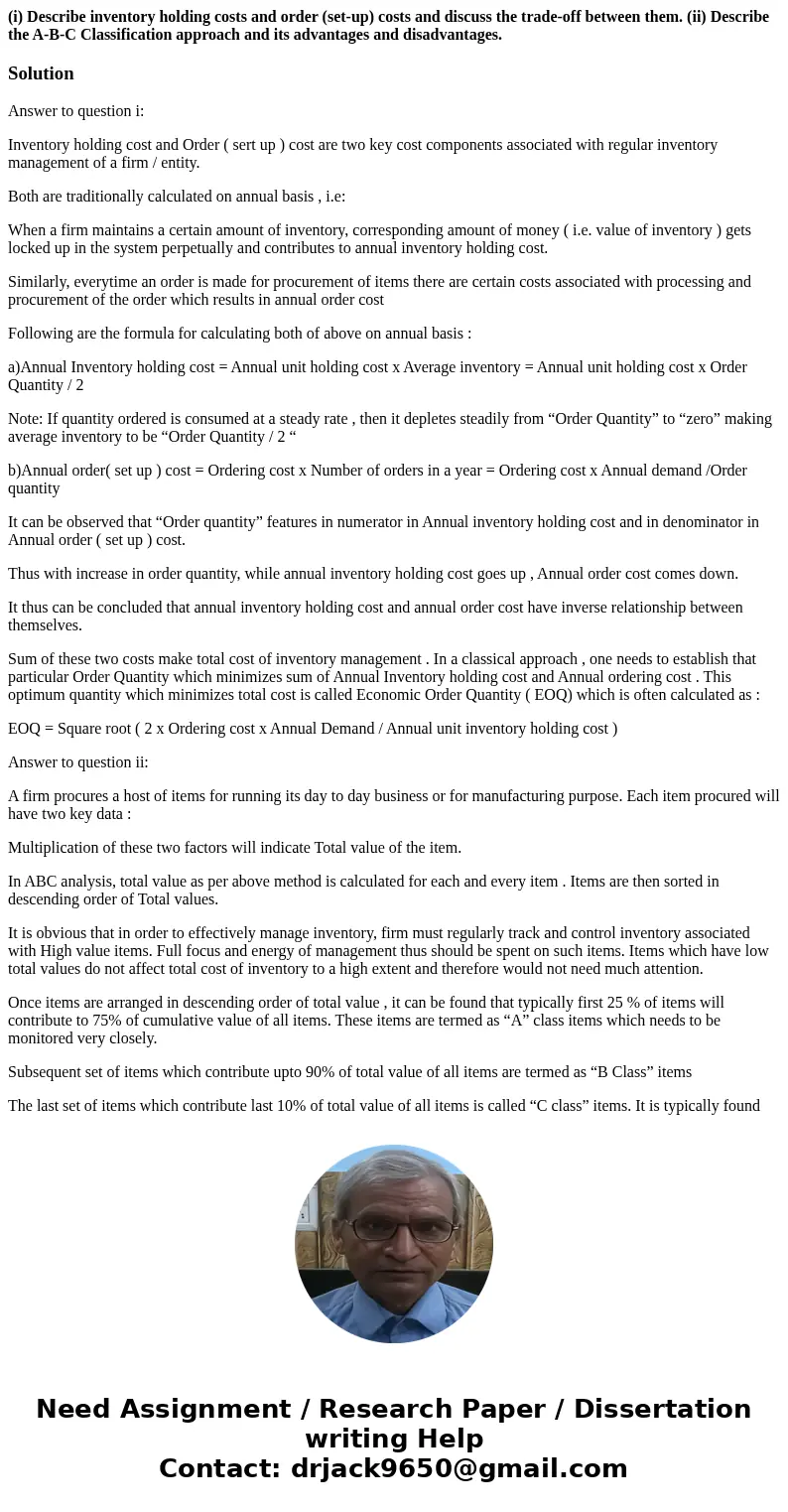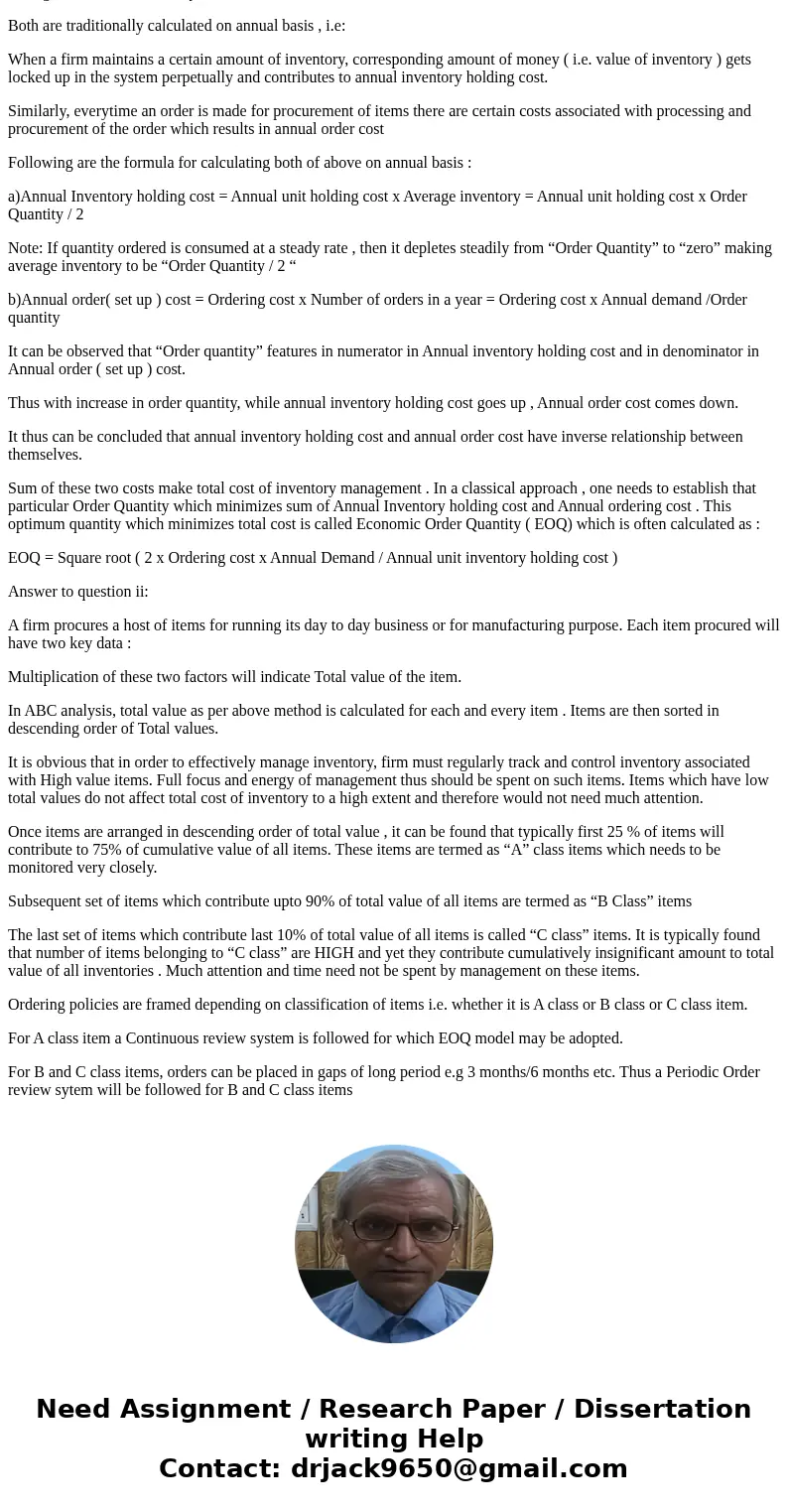i Describe inventory holding costs and order setup costs and
(i) Describe inventory holding costs and order (set-up) costs and discuss the trade-off between them. (ii) Describe the A-B-C Classification approach and its advantages and disadvantages.
Solution
Answer to question i:
Inventory holding cost and Order ( sert up ) cost are two key cost components associated with regular inventory management of a firm / entity.
Both are traditionally calculated on annual basis , i.e:
When a firm maintains a certain amount of inventory, corresponding amount of money ( i.e. value of inventory ) gets locked up in the system perpetually and contributes to annual inventory holding cost.
Similarly, everytime an order is made for procurement of items there are certain costs associated with processing and procurement of the order which results in annual order cost
Following are the formula for calculating both of above on annual basis :
a)Annual Inventory holding cost = Annual unit holding cost x Average inventory = Annual unit holding cost x Order Quantity / 2
Note: If quantity ordered is consumed at a steady rate , then it depletes steadily from “Order Quantity” to “zero” making average inventory to be “Order Quantity / 2 “
b)Annual order( set up ) cost = Ordering cost x Number of orders in a year = Ordering cost x Annual demand /Order quantity
It can be observed that “Order quantity” features in numerator in Annual inventory holding cost and in denominator in Annual order ( set up ) cost.
Thus with increase in order quantity, while annual inventory holding cost goes up , Annual order cost comes down.
It thus can be concluded that annual inventory holding cost and annual order cost have inverse relationship between themselves.
Sum of these two costs make total cost of inventory management . In a classical approach , one needs to establish that particular Order Quantity which minimizes sum of Annual Inventory holding cost and Annual ordering cost . This optimum quantity which minimizes total cost is called Economic Order Quantity ( EOQ) which is often calculated as :
EOQ = Square root ( 2 x Ordering cost x Annual Demand / Annual unit inventory holding cost )
Answer to question ii:
A firm procures a host of items for running its day to day business or for manufacturing purpose. Each item procured will have two key data :
Multiplication of these two factors will indicate Total value of the item.
In ABC analysis, total value as per above method is calculated for each and every item . Items are then sorted in descending order of Total values.
It is obvious that in order to effectively manage inventory, firm must regularly track and control inventory associated with High value items. Full focus and energy of management thus should be spent on such items. Items which have low total values do not affect total cost of inventory to a high extent and therefore would not need much attention.
Once items are arranged in descending order of total value , it can be found that typically first 25 % of items will contribute to 75% of cumulative value of all items. These items are termed as “A” class items which needs to be monitored very closely.
Subsequent set of items which contribute upto 90% of total value of all items are termed as “B Class” items
The last set of items which contribute last 10% of total value of all items is called “C class” items. It is typically found that number of items belonging to “C class” are HIGH and yet they contribute cumulatively insignificant amount to total value of all inventories . Much attention and time need not be spent by management on these items.
Ordering policies are framed depending on classification of items i.e. whether it is A class or B class or C class item.
For A class item a Continuous review system is followed for which EOQ model may be adopted.
For B and C class items, orders can be placed in gaps of long period e.g 3 months/6 months etc. Thus a Periodic Order review sytem will be followed for B and C class items


 Homework Sourse
Homework Sourse